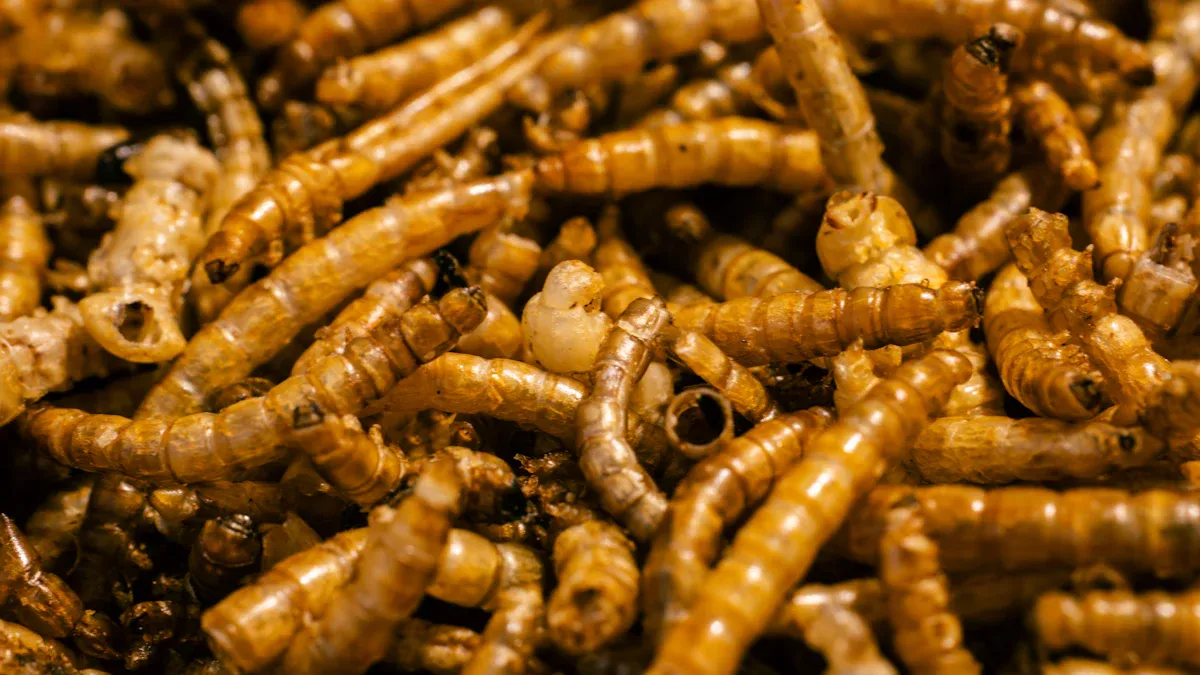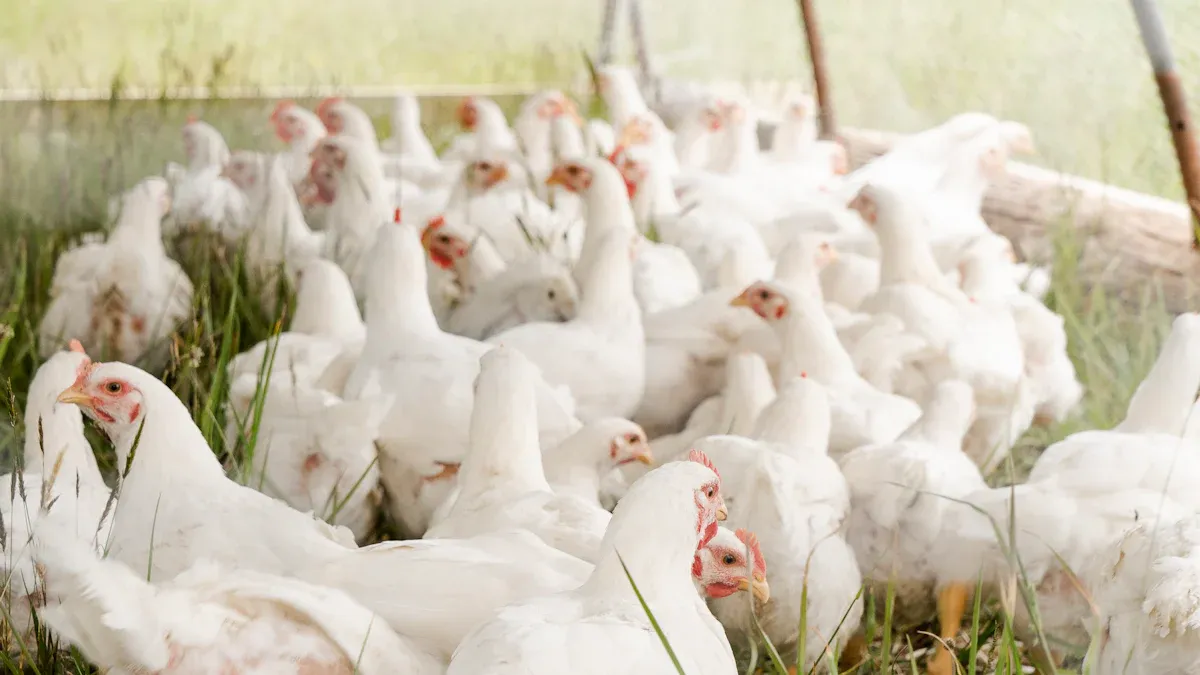
Farmers across North America are embracing mealworms for poultry due to their remarkable nutritional benefits and eco-friendly appeal. Packed with high protein and lipids, yellow mealworms significantly boost poultry growth and health. With demand for sustainable feed sources rising, the market for mealworms continues to grow, offering farmers a practical solution for improving productivity.
Key Takeaways
- Mealworms are full of protein and fats, helping poultry grow strong and stay healthy. They have 59.2% protein, which helps muscles grow and boosts egg laying.
- Feeding mealworms means farmers don’t need as many man-made supplements. This is a natural way to give birds the nutrients they need. It makes birds healthier and improves their feathers.
- Growing mealworms is good for the environment. It creates less pollution and uses less land and water than regular feed. Picking mealworms helps farmers care for the planet.
Nutritional Benefits of Mealworms for Poultry
High Protein and Fatty Acid Content
Mealworms are a powerhouse of nutrition, making them an excellent choice for poultry feed. Their protein content is unmatched, with mealworm meal containing 59.2% crude protein compared to 44% in soybean meal. This high-quality protein supports muscle development, egg production, and overall growth in chickens. Additionally, mealworms boast 24% crude fat, far surpassing the 0.5% found in soybean meal. These fats, rich in essential fatty acids, contribute to healthier feathers and better energy levels in poultry.
Studies have shown that replacing traditional plant-based feeds like soybean meal with mealworm meal can significantly improve poultry performance. Chickens fed mealworms experience better growth rates, increased body weight, and improved feed conversion ratios. This means farmers can achieve higher productivity with less feed, making mealworms a cost-effective and efficient option.
| Nutritional Component | Mealworm Meal (MWM) | Soybean Meal (SBM) |
|---|---|---|
| Crude Protein | 59.2% | 44% |
| Crude Fat | 24% | 0.5% |
| Effect on Broilers | Result |
|---|---|
| Growth Performance | Improved |
| Feed Conversion Ratio | Improved |
| Dressing Percentage | Increased |
Essential Vitamins and Minerals for Poultry Health
Mealworms for poultry are not just about protein and fats; they also provide a rich source of essential vitamins and minerals. These nutrients play a vital role in maintaining poultry health. For example, mealworms are packed with B vitamins, which support energy metabolism and nervous system function. They also contain minerals like calcium, phosphorus, and magnesium, which are crucial for strong bones, eggshell quality, and overall vitality.
The superior amino acid profile in mealworms further enhances their nutritional value. Amino acids like lysine and methionine are essential for feather development and immune system support. By incorporating mealworms into their diets, farmers can ensure their poultry receive a balanced and nutrient-dense feed that promotes optimal health and productivity.
Tip: Adding mealworms to a poultry diet can help reduce the need for synthetic supplements, offering a more natural way to meet nutritional requirements.
Eco-Friendly and Sustainable Feed Option
In addition to their nutritional benefits, mealworms are an environmentally friendly choice for poultry feed. Producing 1 kg of edible mealworm protein generates significantly lower greenhouse gas emissions (20.4 kg CO2-eq) and uses less energy (213.66 MJ-eq) compared to traditional feed sources. This makes mealworms a sustainable alternative for farmers looking to reduce their environmental footprint.
Mealworm farming also requires less land and water than conventional livestock feed production. Studies show that mealworm production has 18–72% lower environmental impacts across various categories, including land use and water consumption. By choosing mealworms for poultry, farmers can contribute to a more sustainable agricultural system while still meeting the nutritional needs of their flocks.
Switching to mealworms not only benefits poultry but also supports eco-friendly farming practices. It’s a win-win for farmers and the planet.
Processing Mealworms for Poultry Feed
Drying and Packaging Methods
Drying and packaging mealworms for poultry feed require careful attention to preserve their nutritional value. Farmers and processors often choose between thermal drying and freeze-drying methods. Thermal drying is cost-effective but can result in fewer fine particles, while freeze-drying maintains the porous structure of mealworms, leading to higher protein fractions. Studies show that freeze-drying is ideal for preserving nutrients, though it may increase costs.
Packaging plays a crucial role in maintaining the quality of dried mealworms. Airtight containers or vacuum-sealed bags are commonly used to prevent moisture and oxidation. These methods ensure that mealworms remain fresh and retain their high protein and fat content, making them a reliable feed option for poultry.
| Aspect | Findings |
|---|---|
| Drying Methods | Thermal drying produces fewer fine particles; freeze-drying preserves structure |
| Protein Enrichment | Dry fractionation achieves up to 66% protein content |
| Packaging Techniques | Airtight and vacuum-sealed options prevent spoilage |
Retaining Nutritional Value During Processing
Processing mealworms for poultry feed requires techniques that minimize nutrient loss. Cooking methods like microwaving and steaming have proven effective in retaining protein digestibility and fatty acid profiles. For example, microwaving enhances digestibility while preserving essential lipids and antioxidants. Steaming also maintains high levels of linoleic acid, which supports poultry health.
On the other hand, high-temperature methods like deep frying or oven cooking at 150°C can reduce digestibility and alter fatty acid composition. Farmers and processors often opt for methods that strike a balance between efficiency and nutritional preservation.
| Cooking Method | Protein Digestibility | Fatty Acid Profile | Oxidative Status |
|---|---|---|---|
| Microwaving | Higher digestibility | Higher tocols | Lower carbonyls |
| Steaming | High digestibility | Increased linoleic acid | Similar to control |
| Oven Cooking (150°C) | Lower digestibility | Decreased SFA/MUFA | Highest carbonyls |
Meeting Quality and Safety Standards
Ensuring the quality and safety of mealworms for poultry feed is essential for farmers. Processing facilities must adhere to strict guidelines to prevent contamination and maintain nutritional integrity. Preprocessing steps, such as cleaning and sorting, are critical for removing impurities. Advanced technologies like high hydrostatic pressure and ultrasound are gaining popularity for their ability to preserve nutrients while ensuring safety.
Packaging standards also play a role in quality control. Labels should clearly indicate nutritional content and expiration dates, helping farmers make informed decisions. By meeting these standards, mealworms for poultry feed remain a trustworthy and sustainable option for North American farmers.
| Processing Method | Nutritional Impact | Cost Efficiency Consideration |
|---|---|---|
| Preprocessing | Critical for minimizing nutritional loss | Tailored to specific nutrient compositions |
| Nutrient Extraction | Green technologies enhance nutrient preservation | Potential for improved safety standards |
How Mealworms Enhance Poultry Immunity and Health
Strengthening the Immune System
Mealworms are more than just a protein source; they actively boost poultry immunity. Their natural composition includes chitin, lauric acid, and antimicrobial peptides, which work together to enhance the immune response. These compounds help reduce harmful gut bacteria, creating a healthier digestive environment for poultry.
Scientific studies back up these benefits. For example, research by Gasco et al. (2018) highlights how mealworms improve gut health and immunity. Other studies, like those by Farooqi et al. (2005) and Choudhury et al. (1998), show similar results, reinforcing the role of mealworms in supporting poultry health.
| Study Reference | Findings | Impact on Poultry Immunity |
|---|---|---|
| Gasco et al. (2018) | Chitin, lauric acid, and antimicrobial peptides improve health | Enhances immune response and reduces harmful gut microbiota |
| Farooqi et al. (2005) | Similar results with betaine supplementation | Supports immune enhancement |
| Choudhury et al. (1998) | Consistent findings with T. molitor | Reinforces immune benefits |
Farmers who include mealworms in their poultry feed often notice stronger, healthier birds. This natural immunity boost reduces the need for antibiotics, making mealworms a practical and sustainable choice.
Supporting Growth and Feather Quality
Mealworms for poultry provide essential nutrients that directly impact growth and feather quality. Their high protein content supports muscle development, while fatty acids like linoleic acid contribute to shiny, healthy feathers. Vitamins and minerals in mealworms, such as B vitamins and magnesium, also play a role in overall vitality.
Feathers are a key indicator of poultry health. Birds with access to nutrient-rich feeds, like mealworms, develop stronger, more vibrant plumage. This not only improves their appearance but also enhances their ability to regulate body temperature. Farmers often report faster growth rates and better feather conditions when mealworms are part of the diet.
Tip: Adding mealworms to a poultry diet can help reduce the need for synthetic supplements, offering a natural way to improve feather quality and growth.
Reducing Disease Susceptibility
Poultry fed with mealworms tend to be more resilient against diseases. The antimicrobial properties of mealworms help maintain a balanced gut microbiota, which is crucial for overall health. A healthy gut reduces the risk of infections and improves nutrient absorption, leading to stronger birds.
Studies like those by Hussain et al. (2017) and Khatun et al. (2005) show that mealworms not only improve immunity but also enhance broiler performance. Farmers benefit from healthier flocks and lower mortality rates, which translates to higher productivity and profitability.
By incorporating mealworms into their feeding practices, North American farmers can reduce disease susceptibility in their poultry. This makes mealworms a valuable addition to any sustainable farming strategy.
Practical Tips for Feeding Mealworms to Poultry

Recommended Feeding Quantities and Frequency
Farmers often wonder how much mealworms their poultry should consume. The answer depends on the bird’s age, size, and purpose. For instance, broiler chickens benefit from mealworms as a protein supplement, with 5-10% of their total feed being ideal. Layers, on the other hand, may require slightly less, as their focus is on egg production rather than rapid growth.
Feeding frequency also matters. Offering mealworms once or twice a day as a treat or mixed into regular feed works well. Overfeeding can lead to imbalances, so sticking to recommended quantities ensures optimal health and performance. Farmers who monitor their flock’s response to mealworms can adjust the amounts as needed.
Tip: Start with small quantities and gradually increase to observe how your poultry adapts to the new diet.
Incorporating Mealworms into Poultry Diets
Adding mealworms to poultry diets is straightforward and versatile. Farmers can mix dried mealworms directly into feed or offer them as a standalone treat. Studies highlight the benefits of insect-based diets. For example, research in Kenya showed that replacing up to 75% of fishmeal with black soldier fly larvae maintained broiler performance. Similarly, Egyptian quail fed insect meal experienced improved weight gain and feed efficiency.
| Study Location | Poultry Type | Insect Type | Replacement Level | Findings |
|---|---|---|---|---|
| Egypt | Japanese Quail | Egyptian cotton leafworm larvae | Up to 100% of bone meal | Improved body weight gain and feed conversion ratio without performance loss |
| Kenya | Broiler Chickens | Black soldier fly larvae | Up to 75% of fishmeal | Maintained performance |
| Kenya | Broiler Chickens | Black soldier fly pre-pupae | 150 g/kg of soybean meal | No effect on performance or meat quality |
Mealworms for Poultry offer similar advantages, providing a rich source of protein, fats, and essential nutrients. Their inclusion supports growth, digestion, and overall health.
Proper Storage and Handling Practices
Proper storage ensures mealworms retain their nutritional value and remain safe for poultry. Farmers should sanitize storage bins by removing old grain and dust. Screening grain before storage helps eliminate fine materials and broken kernels. Regular monitoring is essential, especially during warm months, to check for pests or mold.
If hot spots or mold appear, aerating the grain reduces moisture and temperature. For long-term storage exceeding six months, applying an approved insecticide can prevent infestations. Following these practices keeps mealworms fresh and ready for use.
Note: Store mealworms in airtight containers to maintain their quality and prevent spoilage.
Mealworms for Poultry have proven to be a game-changer for North American farmers. Studies show they can replace traditional feed sources like fish or soybean meal while maintaining or improving poultry growth performance. Enhanced nutrient digestibility further boosts productivity. By adopting mealworms, farmers can support sustainable practices and ensure healthier, more productive flocks.
FAQ
What are the main benefits of feeding mealworms to poultry?
Mealworms provide high protein, essential fatty acids, and vitamins. They improve growth, immunity, and feather quality while supporting sustainable farming practices.
How often should farmers feed mealworms to their poultry?
Farmers can feed mealworms once or twice daily. Mixing them into regular feed or offering them as treats works best.
Tip: Start with small amounts and adjust based on flock response.
Are mealworms safe for all types of poultry?
Yes, mealworms are safe for chickens, ducks, and other poultry. Their natural nutrients benefit birds of all ages and purposes, from layers to broilers.
Note: Always store mealworms properly to maintain their quality.

